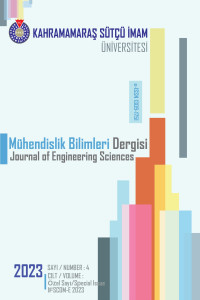ULTRASONIC PILOT REACTOR DESIGN: TEMPERATURE, PRESSURE AND ROTARY CONTROL CAN BE USED IN THE PRODUCTION OF HYGROSCOPIC MATERIALS
Abstract
Substances such-as zinc-chloride, sodium-hydroxide, magnesium-oxide, calcium-oxide retain water in-their crystals by means of diffusion/absorption due-to their chemical structure. These substances’re called hygroscopic substances and are-used to remove water from liquids/solids. Although special closed systems’re required for their production, reaction chambers at-high temperatures’re required for the removal of-water that enters the environment or absorbed by material from environment and for calcination processes. It’s necessary to remove gases formed during reaction of hygroscopic-substances from environment or to-remove water vapor from system to-prevent product from getting humid. When reactors in market’re examined, they show negative aspects such-as clumping, bulky structures, high energy requirements and contact with air during packaging processes. In this study, it’s aimed to determine boundary conditions and 3D designs of new pilot reactor unit to be used in-production process and chemical reactions of related chemicals, based-on calcium/magnesium oxide. Boundary conditions were determined by examining reactors that are widely used in market. 3D designs were made according to determined needs and according to data obtained, new system’s designed, that is 42% lighter and 50% smaller than conventional systems. With study, new reactor was designed with components that have at-least 38% more product processing capacity and reduce energy use by 25%.
Project Number
OSB.22.005
References
- Deng, F., Wang, C., Xiang, C. and Wang, R. (2021). Bioinspired topological design of super hygroscopic complex for cost-effective atmospheric water harvesting. Nano Energy, 90, B. https://doi.org/10.1016/j.nanoen.2021.106642.
- Europen Patent Office. (2023a). https://worldwide.espacenet.com/patent/search/family/083712025/publication/ CN217662704U?q=num%20%3D%20%22CN217662704%22. Accessed 10.08.23 Europen Patent Office. (2023b). https://worldwide.espacenet.com/patent/search/family/083712025/publication/ CN217662704U?q=num%20%3D%20%22CN217662704%22
- He, F., Weon, S., Jeon, W. et al. (2021). Self-wetting triphase photocatalysis for effective and selective removal of hydrophilic volatile organic compounds in air. Nat Commun, 12, 6259. https://doi.org/10.1038/s41467-021-26541-z
- Kallenberger, P. A., Fröba, M. (2018). Water harvesting from air with a hygroscopic salt in a hydrogel–derived matrix. Commun Chem, 1, 28. https://doi.org/10.1038/s42004-018-0028-9.
- Kiat, J. M., Boemare, G., Rieu, B. and Aymes, D. (1998). Structural evolution of LiOH: evidence of a solid–solid transformation toward Li2O close to the melting temperature. Solid State Communications, 108, 4, 241-245, https://doi.org/10.1016/S0038-1098(98)00346-9.
- Liang, J., Zhang, X., Ji, J. (2021). Hygroscopic phase change composite material—A review. Journal of Energy Storage, 36. https://doi.org/10.1016/j.est.2021.102395
- Osanyintola, O. F. and Simonson, J. C. (2006). Moisture buffering capacity of hygroscopic. 38, 1270-1282,. https://doi.org/10.1016/j.enbuild.2006.03.026.
- Sharma, S. K., Jotshi, C. K., and Kumar, S. (1991). Kinetics of dehydration of sodium salt hydrates. Thermochimica Acta, 184(1), 9–23. https://doi.org/10.1016/0040-6031(91)80130-b.
- Wang, W., Wu, L., Li, Z., Fang, Y., Ding, J. and Xiao, J. (2013) An overview of adsorbents in the rotary desiccant dehumidifier for air dehumidification. Drying Technology, 31, 12, 1334-1345. https://doi.org/10.1080/07373937.2013.792094.
HİGROSKOPİK MADDELERİN ÜRETİMİNDE KULLANILABİLİR SICAKLIK, BASINÇ VE KARIŞTIRMA KONTROLLÜ ULTRASONİK PİLOT REAKTÖR TASARIMI
Abstract
Çinko klorür, sodyum hidroksit, magnezyum oksit, kalsiyum oksit gibi maddeler kimyasal yapıları gereği kristalleri içerisine difüzyon/absorpsiyon gibi yollarla su tutarlar. Bu maddeler, higroskopik maddeler olarak adlandırılıp sıvı ve katılar maddelerden su uzaklaştırmak amacıyla kullanılmaktadır. Üretimleri amacıyla özel kapalı sistemler kullanılması gerekmekle birlikte ortama giren veya maddenin absorpladığı suyun ortamdan uzaklaştırılması ve kalsinasyon işlemleri için yüksek sıcaklıklarda tepkime odaları gerekmektedir. Higroskopik maddelerin tepkimesi sırasında ortaya çıkan gazların ortamdan uzaklaştırılması veya ürünün nemlenmesi önlemek için su buharının sistemden uzaklaştırılması gerekmektedir. Piyasada yer alan reaktörler incelendiğinde başta topaklanma, hantal yapıları, yüksek enerji gereksinimleri ve paketlenme süreçlerinde havayla temas gibi olumsuzluklar göstermektedirler. Bu çalışma ile kalsiyum oksit ve magnezyum oksit temel alınmak üzere, ilgili kimyasalların üretim prosesinde ve kimyasal tepkimelerinde kullanılmak amacıyla yeni bir pilot reaktör ünitesinin sınır şartlarının belirlenmesi ve 3B tasarımlarının yapılması amaçlanmıştır. Piyasada yaygın kullanımı olan reaktörler incelenerek sınır şartları belirlenmiştir. Belirlenen ihtiyaçlara göre 3 boyutlu tasarımları gerçekleştirilmiştir olup elde edilen verilere göre mevcut sistemlere göre %42 daha hafif, %50 daha küçük yeni bir sistem tasarlanmıştır. Çalışma ile en az %38 daha fazla ürün işleme kapasitesine sahip olup %25 oranında enerji kullanımını azaltan bileşenlerden oluşan yeni bir reaktörün tasarımı gerçekleşmiştir.
Supporting Institution
Tarsus Üniversitesi
Project Number
OSB.22.005
Thanks
Bu çalışma Tarsus Üniversitesi Bilimsel Araştırma Projeleri (BAP) kapsamında OSB.22.005 proje numarasıyla desteklenmiştir.
References
- Deng, F., Wang, C., Xiang, C. and Wang, R. (2021). Bioinspired topological design of super hygroscopic complex for cost-effective atmospheric water harvesting. Nano Energy, 90, B. https://doi.org/10.1016/j.nanoen.2021.106642.
- Europen Patent Office. (2023a). https://worldwide.espacenet.com/patent/search/family/083712025/publication/ CN217662704U?q=num%20%3D%20%22CN217662704%22. Accessed 10.08.23 Europen Patent Office. (2023b). https://worldwide.espacenet.com/patent/search/family/083712025/publication/ CN217662704U?q=num%20%3D%20%22CN217662704%22
- He, F., Weon, S., Jeon, W. et al. (2021). Self-wetting triphase photocatalysis for effective and selective removal of hydrophilic volatile organic compounds in air. Nat Commun, 12, 6259. https://doi.org/10.1038/s41467-021-26541-z
- Kallenberger, P. A., Fröba, M. (2018). Water harvesting from air with a hygroscopic salt in a hydrogel–derived matrix. Commun Chem, 1, 28. https://doi.org/10.1038/s42004-018-0028-9.
- Kiat, J. M., Boemare, G., Rieu, B. and Aymes, D. (1998). Structural evolution of LiOH: evidence of a solid–solid transformation toward Li2O close to the melting temperature. Solid State Communications, 108, 4, 241-245, https://doi.org/10.1016/S0038-1098(98)00346-9.
- Liang, J., Zhang, X., Ji, J. (2021). Hygroscopic phase change composite material—A review. Journal of Energy Storage, 36. https://doi.org/10.1016/j.est.2021.102395
- Osanyintola, O. F. and Simonson, J. C. (2006). Moisture buffering capacity of hygroscopic. 38, 1270-1282,. https://doi.org/10.1016/j.enbuild.2006.03.026.
- Sharma, S. K., Jotshi, C. K., and Kumar, S. (1991). Kinetics of dehydration of sodium salt hydrates. Thermochimica Acta, 184(1), 9–23. https://doi.org/10.1016/0040-6031(91)80130-b.
- Wang, W., Wu, L., Li, Z., Fang, Y., Ding, J. and Xiao, J. (2013) An overview of adsorbents in the rotary desiccant dehumidifier for air dehumidification. Drying Technology, 31, 12, 1334-1345. https://doi.org/10.1080/07373937.2013.792094.
Details
| Primary Language | Turkish |
|---|---|
| Subjects | Chemical Process Design, Machine Design and Machine Equipment, Powder and Particle Technology |
| Journal Section | Mechanical Engineering |
| Authors | |
| Project Number | OSB.22.005 |
| Publication Date | December 12, 2023 |
| Submission Date | August 11, 2023 |
| Published in Issue | Year 2023 Volume: 26 Issue: Özel Sayı - 9th Uluslararası IFS Çağdaş Matematik ve Mühendislik Konferansı (IFSCOM-E) Özel Sayısı |

